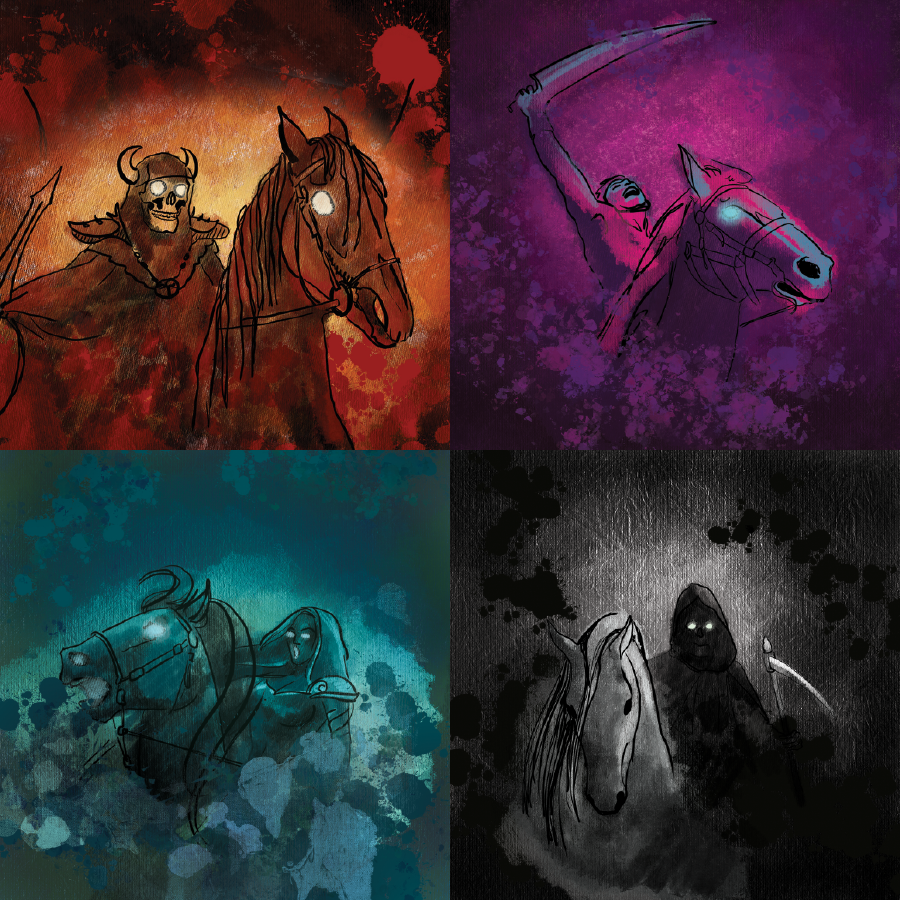The so-called “Four Horsemen of the Apocalypse”have occupied a dark, terrifying place in the Christian faith ever since John of Patmos, which may well have been the pseudonym of Roman emperor Domitian, authored Revelation in the first century A.D. Specifically appearing in Revelation 6:4-8, each of these ghastly figures symbolizes the coming of one of the four great cataclysmic events that will signify the rise of the Antichrist, the final conflict between Heaven and Hell, and the second coming of Jesus Christ. Although they appear classically in the Bible as Conquest, War, Famine, and Death, two millennia of analysis, literary tradition, and imagination have morphed their identities into the more separate War, Famine, Pestilence/Plague, and Death.

In the same course of that two thousand years, there has been significant discussion regarding the meaning of the events described in Revelation, which we have no need to discuss here. The point is really that these four entities, personifications of the various events that will lead to the end of the world, have existed as part of Western mythology (used here to describe the stories told via literary and oral tradition rather than regarding any claims of validity) for a very, very long time.
As a result, they’ve ended up as part of pop culture as well, appearing in books, movies, and even children’s cartoons like Courage the Cowardly Dog. Given my affinity for Halloween and spooky, apocalyptic tales, I’ve wanted to produce a series of fragrances centered around this theme for some years now, so we’ve decided to finally do it! Here’s how it breaks down:
Everything is centered around a core accord, which represents Death. Logically, the other three horsemen are really just facets of Death, so there’s a certain thematic significance to offering War, Famine, and Plague as variations upon the ultimate end. A classic, mossy, resinous chypre (“sheep-ruh”), Death’s entire design is constructed around an elemental and timeless character that smells like it just came from the primordial ooze. This is the scent of an entity that was here before anything else, and will continue long after Everything™ is nothing but dust and ashes.
Famine is, as mentioned, a sort of fragrance overlay built upon the core accord. Specifically designed to recall aromas of dust and desiccation, it incorporates a peculiar series of materials, particularly the aroma chemical Norlimbanol, which is frequently used to dry out masculine fragrances and give them the strangely spiky tang that one might associate with chemical desiccants or dry ice. Famine is my personal favorite of the four, both for its artwork and for the construction of the fragrance, and we’re really looking forward to getting it out for people to smell.
Plague is perhaps the most obvious of the set, constructed from a series of herbs built upon the chypre core and meant to recall the herbal poultices used by plague doctors in their famous beaked face masks to help prevent the transmission of “miasmas” that they believed caused disease. It was common for such individuals (it’s hard to call them “physicians” by any modern standard) to fill the beaks of their masks with lavender, thyme, sage, or other strong herbs and flowers, and I’ve chosen to elaborate upon this idea a bit by incorporating not only those three plants, but rosemary and geranium as well in order to tame what was seen as the beneficial pungency of the herbs. It’s lovely, actually.
War is definitely the most unusual of the four designs. Encapsulating the scent of a battlefield is a difficult and baroque idea, and it’s important to not venture too far down the proverbial rabbit hole so that we avoid incorporating the smell of artillery victims and human suffering in any kind of realistic format. Spoiler: we did not do that. But I’ve instead decided to attempt to represent the aromas of hot metal and gunpowder, which we so thoroughly associate with the last four to five hundred years of warfare, through the use of two separate accords that I designed for the purpose. To avoid the fragrance reeking of burned propellant, I’ve kept the gunpowder note quite light, but the strange, ethereal ozonic note of hot metal is here in full force, offering a clean-but-unsettling cast to the fragrance that I’m really pleased with, and which I think is both interesting and distinctive. One thing is for certain: you will never mistake War for anything else.
I’ll leave the full details of the release for the pre-order next week, but, as a slight spoiler, we’ll be offering some really cool gear this year. Nothing super elaborate or expensive, but definitely the kind of gear that folks have been asking us for, and which you’ll be happy to have all year round.
One final thing: Originally, we had planned to make samples of all four fragrances available on Tuesday, September 27th. But, after handling the samples a bit, I’d really like them to dry out a bit more so that they’re not overly sticky or difficult to work with. As such, we’ve pushed the sample drop back to Thursday, September 29th. The pre-order opens next Tuesday, October 4th, and will be open for a full week, so you should have plenty of time to give all four fragrances a try to see what you might like to order from us.
This is one of our most thematically elaborate releases yet, and I’m really pleased to have been able to get it ready for Halloween this year. Hope you like it as much as I do!
-Will



Comments
Going against the tide here, but War is my favorite. (On my husband, it smells terrible on me!) It is an unusual metallic (ozone?) and cilantro smell. Perhaps like a sword wielded on a hot battlefield.
If I had known someone was throwing it away I would have grabbed it from their hands. I ordered several bottles to hoard, but there are the dark days ahead when it is all gone.
OK. I bought the samples of all four scents. War, that’s a strong no. I discarded it immediately. The coppery notes reminded me of a bloody nose.
I’ve started [6/30/2023] using the sample of Plague. Boy, has it grown on me. I wish I had more. It is both dank and bright with herbal notes that few other fragrances have. It is complex and charming.
I like Death as well, for the same reasons. Although Plague seems more, er, optimistic.
Any thoughts on bringing the top 1-2 of the series back under a new name?
This is my first “official” order from B&M but I have purchased their aftershave and samples from Maggard previously. I was bond excited when I came across a notice for the Four Horseman lineup and immediately went to the website and ordered samples of all four. One thing with this collection is, you will never mistake it for anything else. The soap base in each is the same and it is what one would expect from B&M. Thick, slick, cushiony and any other adjective you care to include. The scents are as unique (with some overlap) as any scent you will encounter. I list their personal appeal to me in the following order:
1) Death- An intoxicate smell that welcomes and beckons you like the crooked finger of the Angel of Death itself. Mossy, earthy and calming (like a creeping death) this scent is one that hints that Armageddon may not be that horrible.
2) Plague – Building on the floral mossy(ness) of Death, plague brings with it a hint of danger. The smells together appear to hide an acrid background that is a harbinger of the pestilence that a plague has to offer.
3) Famine- Hinting of notes of its predecessor Death, famine has an acrid smell of fruit that has reached an overripe phase and is no longer suitable for consumption. While still alluring and intoxicating, Famine begins to bring with it an air of concern that perhaps the next step down the scent path will result in your demise.
4) War- Admittedly, not a scent I cared for but perhaps it is because the smell it so harsh to the sense that it is something I wish to flee from. The “ozone” smell to me assaulted me with, what I perceived, was an overwhelming odor of cilantro. Just like an actual war, this is a scent that will assault you and the residual scent will remain just like the ravages of war.